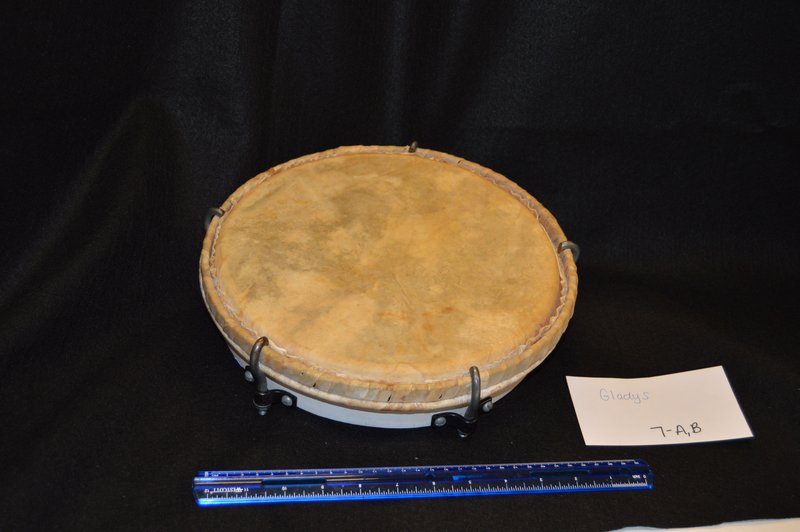Pandero (Drum)
Title
Subject
Music
Music—Latin American Influences
Drum
Frame drums
Plenas
Folk songs, Spanish—Puerto Rico
Description
The pandero is a percussion instrument that is a member of the Membranophone family. The pandero is a very popular instrument, and it is very significant throughout Latin America but it is especially important in Puerto Rico. In my research, I found that the history of the pandero is not entirely clear unfortunately, it is a small hand-held drum that is used to play plenas, a genre of folk music.
The background history on the pandero is unclear since different countries have different names and the history for each is different. However, the one thing that they all agree on is that it was brought over through migration, with little agreement by who and when. In Puerto Rico, it has two different names: the pandero and panderetas. There are some who disagree about whether the Pandero that is played in Puerto Rico today is same instrument from Spain that is known as the “adufe” or if it originated from Africa (Cohen, 2008). However, even though the history is incomplete and different, the description is always the same.
The pandero is described as a small hand-held drum that resembles a tambourine that may or may not have cymbals. A pandero comes in many different sizes, but ranges between twenty three to twenty eight inches. It is typically made up of stretched animal skin over a piece of wood which makes it part of the membranophone family. It is also not uncommon to find one made up of plastic. To play the pandero, one will alternate between hitting it with their thumb, fingertips, the heel, and the palm of their hand. The pandero is usually played in Plena Music.
The pandero is used to play a genre of music that is called plena and it reflects class divisions in the Puerto Rican community. Plena was a very popular type of music in Puerto Rico and the United States when Puerto Ricans migrated here. It was quite popular as a genre up until the 1930’s and it was very popular in the 1920’s in New York. Plena is an Afro- Puerto Rican music that is known as being “musical newspapers” (Glasser, 1995). Plenas are typically songs that one would sing that would reflect their daily life or what was going on around them and even international news. Plenas are typically short only having four repetitive verses. Plenas were very unpopular to the upper-class citizens as well as the government who characterized such musicians as bad people who were distasteful, violent, sexually active and had “low morals,” and because of its clear African roots (Glasser, 1995). During the 1920’s plenas were written about President Hoover, prohibition and even as a way to deal with World War I. “El submarine aleman,/ llorban los marineros, llorban hasta el capitain’( The German submarine, the German submarine,/ the sailors cries, everyone cried, even the captain)” was written about the sinking of the Carolina (Glasser, 1995). Coming up with plenas was a way to pass the time and allowed for some type of enjoyment especially during hard times. Plenas are not quite as popular today but Latin music is and the percussion is a big part of that.
Percussion instruments are in a whole different category when it comes to Latin music. Percussion instruments have many different styles and sounds within each different rhythm pattern. Which each different rhythm you can get the sounds of plenas, samba, salsa, mambo merengue, and cumbia. Some of these sounds are still popular today. The percussion is the most important instrument when it comes to keeping the rhythm of a song. There was a time when Latin music was not played like it is today. Some considered Latin music to be a gift as it has enriched our own music. Latin musicians were successful in being able to bridge together different types of music. Which allowed for all different audiences to listen to and enjoy.
Despite its unclear history, the pandero is an important piece of Puerto Rican history. It was used to as a form of entertainment to tell stories and pass the time. Unfortunately, its own history is not as quite clear. Moreno-Fuentes is very proud of it and the importance of the traditional Puerto Rican music. Percussion instruments like the pandero are very important to music today especially Latin music which is based on rhythm which gives us the music we enjoy todayCohen, Judith R. "'This Drum I Play': Women and Square Frame Drums in Portugal and Spain."Ethnomusicology Forum 17, no. 1, 95-124. https://www.tandfonline.com/doi/full/10.1080/17411910801972966?scroll=top&needAccess=true
Glasser, Ruth. My Music Is My Flag : Puerto Rican Musicians and Their New York Communities, 1917-1940. Berkley: University of California Press, 1995.
Nelson, William Javier. "Their Loss — Our Gain: The Gift of Latin Music in the United States." Afro-Hispanic Review 6, no. 2 (1987): 19-24. http://www.jstor.org/stable/23053899.
Schroeder, Pollyanna T. "The Growth of Latin American Pop Music in the United States." College Music Symposium 18, no. 2 (1978): 124-29. http://www.jstor.org/stable/40373975.
Creator
Source
Publisher
Date
Accession Date: April 12, 2018
Contributor
Rights
Format
Diameter of about 12 inches.
